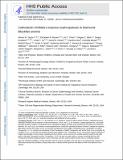Calmodulin inhibitors improve erythropoiesis in Diamond-Blackfan anemia
Author(s)
Taylor, Alison M; Macari, Elizabeth R; Chan, Iris T; Blair, Megan C; Doulatov, Sergei; Vo, Linda T; Raiser, David M; Siva, Kavitha; Basak, Anindita; Pirouz, Mehdi; Shah, Arish N; McGrath, Katherine; Humphries, Jessica M; Stillman, Emma; Alter, Blanche P; Calo, Eliezer; Gregory, Richard I; Sankaran, Vijay G; Flygare, Johan; Ebert, Benjamin L; Zhou, Yi; Daley, George Q; Zon, Leonard I; ... Show more Show less
DownloadAccepted version (1.272Mb)
Open Access Policy
Open Access Policy
Creative Commons Attribution-Noncommercial-Share Alike
Terms of use
Metadata
Show full item recordAbstract
© 2020 The Authors, some rights reserved; exclusive licensee American Association for the Advancement of Science. No claim to original U.S. Government Works Diamond-Blackfan anemia (DBA) is a rare hematopoietic disease characterized by a block in red cell differentiation. Most DBA cases are caused by mutations in ribosomal proteins and characterized by higher than normal activity of the tumor suppressor p53. Higher p53 activity is thought to contribute to DBA phenotypes by inducing apoptosis during red blood cell differentiation. Currently, there are few therapies available for patients with DBA. We performed a chemical screen using zebrafish ribosomal small subunit protein 29 (rps29) mutant embryos that have a p53-dependent anemia and identified calmodulin inhibitors that rescued the phenotype. Our studies demonstrated that calmodulin inhibitors attenuated p53 protein amount and activity. Treatment with calmodulin inhibitors led to decreased p53 translation and accumulation but does not affect p53 stability. A U.S. Food and Drug Administration-approved calmodulin inhibitor, trifluoperazine, rescued hematopoietic phenotypes of DBA models in vivo in zebrafish and mouse models. In addition, trifluoperazine rescued these phenotypes in human CD34+ hematopoietic stem and progenitor cells. Erythroid differentiation was also improved in CD34+ cells isolated from a patient with DBA. This work uncovers a potential avenue of therapeutic development for patients with DBA.
Date issued
2020Department
Massachusetts Institute of Technology. Department of Biology; Koch Institute for Integrative Cancer Research at MIT; Howard Hughes Medical InstituteJournal
Science Translational Medicine
Publisher
American Association for the Advancement of Science (AAAS)